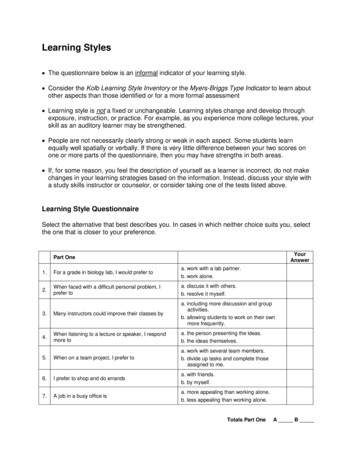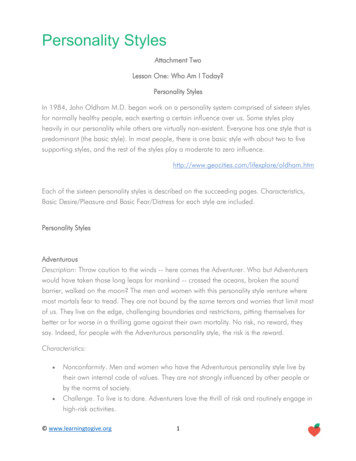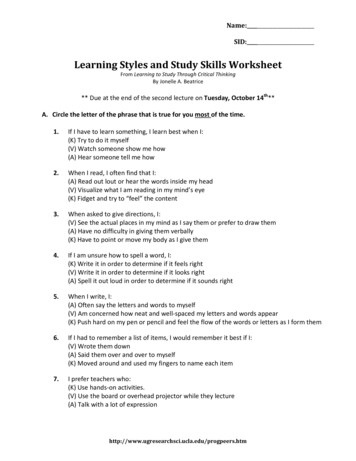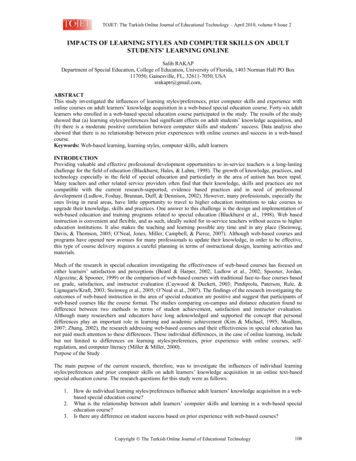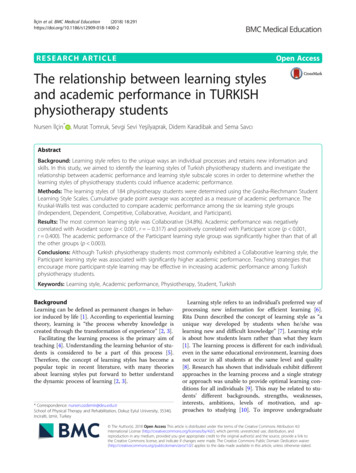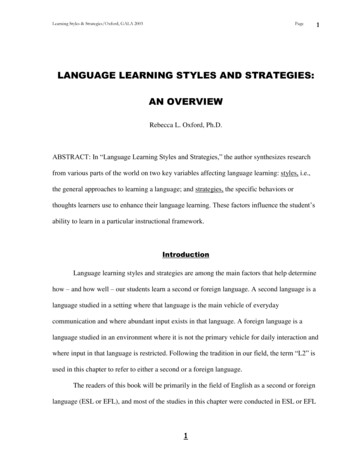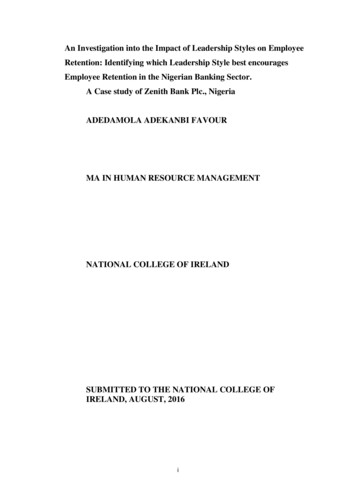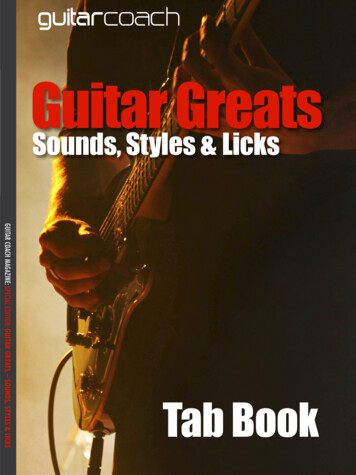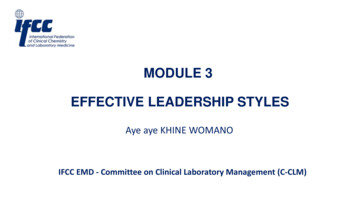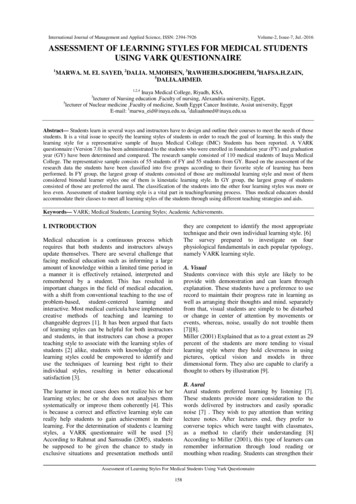
Transcription
International Journal of Management and Applied Science, ISSN: 2394-7926Volume-2, Issue-7, Jul.-2016ASSESSMENT OF LEARNING STYLES FOR MEDICAL STUDENTSUSING VARK QUESTIONNAIRE1MARWA. M. EL SAYED, 2DALIA. M.MOHSEN, 3RAWHEIH.S.DOGHEIM, 4HAFSA.H.ZAIN,5DALIA.AHMED.1,2,4Inaya Medical College, Riyadh, KSA.lecturer of Nursing education ,Faculty of nursing, Alexandria university, Egypt,5lecturer of Nuclear medicine ,Faculty of medicine, South Egypt Cancer Institute, Assiut university, EgyptE-mail: 1marwa eid@inaya.edu.sa, 5daliaahmed@inaya.edu.sa3Abstract— Students learn in several ways and instructors have to design and outline their courses to meet the needs of thosestudents. It is a vital issue to specify the learning styles of students in order to reach the goal of learning. In this study thelearning style for a representative sample of Inaya Medical College (IMC) Students has been reported. A VARKquestionnaire (Version 7.0) has been administrated to the students who were enrolled in foundation year (FY) and graduationyear (GY) have been determined and compared. The research sample consisted of 110 medical students of Inaya MedicalCollege. The representative sample consists of 55 students of FY and 55 students from GY. Based on the assessment of theresearch data the students have been classified into five groups according to their favorite style of learning has beenperformed. In FY group, the largest group of students consisted of those are multimodal learning style and most of themconsidered bimodal learner styles one of them is kinestatic learning style. In GY group, the largest group of studentsconsisted of those are preferred the aural. The classification of the students into the other four learning styles was more orless even. Assessment of student learning style is a vital part in teaching/learning process. Thus medical educators shouldaccommodate their classes to meet all learning styles of the students through using different teaching strategies and aids.Keywords— VARK; Medical Students; Learning Styles; Academic Achievements.they are competent to identify the most appropriatetechnique and their own individual learning style. [6]The survey prepared to investigate on fourphysiological fundamentals in each popular typology,namely VARK learning style.I. INTRODUCTIONMedical education is a continuous process whichrequires that both students and instructors alwaysupdate themselves. There are several challenge thatfacing medical education such as informing a largeamount of knowledge within a limited time period ina manner it is effectively retained, interpreted andremembered by a student. This has resulted inimportant changes in the field of medical education,with a shift from conventional teaching to the use ofproblem-based, student-centered learning andinteractive. Most medical curricula have implementedcreative methods of teaching and learning tochangeable degrees [1]. It has been argued that factsof learning styles can be helpful for both instructorsand students, in that instructors can chose a properteaching style to associate with the learning styles ofstudents [2] alike, students with knowledge of theirlearning styles could be empowered to identify anduse the techniques of learning best right to theirindividual styles, resulting in better educationalsatisfaction [3].A. VisualStudents convince with this style are likely to beprovide with demonstration and can learn throughexplanation. These students have a preference to userecord to maintain their progress rate in learning aswell as arranging their thoughts and mind. separatelyfrom that, visual students are simple to be disturbedor change in center of attention by movements orevents, whereas, noise, usually do not trouble them[7][8].Miller (2001) Explained that as to a great extent as 29percent of the students are more tending to visuallearning style where they hold cleverness in usingpictures, optical vision and models in threedimensional form. They also are capable to clarify athought to others by illustration [9].B. AuralAural students preferred learning by listening [7].These students provide more consideration to thewords delivered by instructors and easily sporadicnoise [7] . They wish to pay attention than writinglecture notes. After lectures end, they prefer toconverse topics which were taught with classmates,as a method to clarify their understanding [8]According to Miller (2001), this type of learners canremember information through loud reading ormouthing when reading. Students can strengthen theirThe learner in most cases does not realize his or herlearning styles; he or she does not analyses themsystematically or improve them coherently [4]. Thisis because a correct and effective learning style canreally help students to gain achievement in theirlearning. For the determination of students c learningstyles, a VARK questionnaire will be used [5]According to Rahmat and Samsudin (2005), studentsbe supposed to be given the chance to study inexclusive situations and presentation methods untilAssessment of Learning Styles For Medical Students Using Vark Questionnaire158
International Journal of Management and Applied Science, ISSN: 2394-7926memory by listening again to audio recordings, byteaching other people and discussing with instructors.Aural students usually read easily, learn differentforeign language fast, have good vocabulary withcorrect spelling, like to write letters and own strongability in remembering names or facts [9].Volume-2, Issue-7, Jul.-2016from performing an activity, touch, hearing,smell,taste, and sight). The student may mark evenmore choices in case that more answers describe herreactions. Before students complete the questionnaire,they have been advised to choose the answer that bestexplained their preference and circle the letter(s) nextto it, but if necessary they may omit a question orchoose two or three options. Questionnaires wereevaluated on the basis of previously validated scoringinstructions and a chart.Scoring system steps: first find the learner total scoreby summing the responses of V, A, R, and K andlisting descending. Second look at the differencebetween each of the scores through compare this tothe cut-off points for the “mode” or type ofpreference the student corresponds to from theVARK resource pack. This ranges from strongpreference cut-off points, to weak preference cut-offpoints. A score for a mode that stands out from theothers will indicate a strong or very strong preferenceas shown in table (1).C. Read / WriteStudents with the affinity of reading like betterprinted word and text as a method to gain knowledge.They like list, word list, textbooks, lecture notes, orpassage. These students like to arrange lecture notesinto sketch form, paraphrase classroom notes, andstudy multiple alternative exam questions [8] Besidesthat, according to [7]these students are note takers.They study superior through note taken from lectureor from hard reading materials.D. KinestheticLearning through kinesthetic is an extent mode,regarded to the combination of various sensefunctions. Kinesthetic referring to learning achievedusingperform and experience. In other words,kinesthetic students should go through experience tolearn something [8] [7] describes the characteristicsof kinesthetic learners as those who emphasize morein experience in learning something and usually, theyhave high energy and prefer to apply touch.The aim of this study was to describe learning stylesof medical students in Inaya Medical College,Riyadh, Saudi Arabia.Table (1) Determining Learning Preferences ofStudentsStatistical analysis has been done using SPSSversion 20II. METHODSIII. RESULTSThis study was performed at Inaya Medical College,female section Riyadh, Saudi Arabia. The researchsample consisted of 110 female students of InayaMedical College, Riyadh, KSA. The samplecomposed of two groups' foundation and graduationyear groups, each group 55 students.Tool: The VARK questionnaire English version 7.0developed by Fleming (1992)was used in this study toidentify one aspect of student learning styles: thesensory modality by which they prefer to take ininformation. It consisted of 16-item, self-reported,multiple choice questionnaire that can be completedin 10 –15 min. In addition to the personal data such asage and academic level were collected. It wasadministered at the beginning of the second semesterto medical students to determine their preferredmode(s) of learning. The purpose of the study wasexplained to the students, and written informedconsent was obtained before the VARK questionnairewas distributed [10].Participants were asked to describe their learningstyle(s) by choosing from the following options: 1)visual (learning from graphs, charts, flow diagrams,and demos); 2) aural (learning from speech, lectures,and discussions); 3) reading/writing (learning fromreading and writing); and 4) kinesthetic (learningThe resulted data from each learner are shown inAppendix (1).Table (2) The representative sample detailsTable (3) Distribution of FY and GY medicalstudents according to their learning stylepreferencesAs shown in table (3) the distribution of individualgroups of students according to their learning stylepreferences via VARK classification is trulysurprising. Within this context, interesting factsAssessment of Learning Styles For Medical Students Using Vark Questionnaire159
International Journal of Management and Applied Science, ISSN: 2394-7926should be highlighted. For the FY group, it was foundthat the most valued style is kinesthetic learning style,preferred by more than 27% of FY students althoughthe highest value was 41% for multinodular learningstyle but even those who specified as multimodalmost of them choose two styles one of them iskinesthetic. The representation of the other threelearning styles is more or less similar. For GY group,the obtained were different as the most valued style isaural learning style, preferred by more than 38% ofGY students. It resulted from the questionnaire thatthe representation of both FY and GY as far as theirlearning style preferences are concerned is the samein each group and corresponds to the total proportionof FY and GY in the sample. These results can bevisualized for the purpose of clarity by Figure 1.shown below.Volume-2, Issue-7, Jul.-2016specified learning styles, it was noticed they areclassified as bimodal with 36.3% for FY students and23.6% for GY students, trimodal which are 5.5% forFY students and 3.6% for GY and quadmodal styles1.8.6% for GY as shown in figure (3). Also thestudents which are specified as unimodal has beenshown. These findings have significant teaching andresearch implications.Figure (3) Percentages of medical students who preferred touse unimodal, bimodal, trimodal and quadmodal sensorymodalitiesIV. DISCUSSIONAssessment of students' learning style is a valuableskill in education. Knowledge of learning styles mayhelp educators identify and solve learning problemsamong students, thus helping their students to becomemore effective learners [11].The present study revealed several main differencesbetween FY and GY medical students with regards tolearning styles and approaches. Our results showedthat the majority of FY students had multimodallearning styles while GY students has a majority inaural style (39.6%). In a similar study conducted inUSA, the majority (63.8%) had multimodal learningstyles with only 36.1% having a unimodal learningpreference; however auditory learners were only asmall minority (4.8%) [12].In addition, Slater et al.(2007) reported that the majority of male and femalefirst-year medical students utilize multiple sensorymodalities over unimodal learning.(1A) Anotherstudy in Turkey showed similar results with themultimodal approach being the predominant style(63.9%), with only 3.2% being auditory learners [13].Both these studies demonstrated a clearpredominance of kinesthetic learners (18.1% and23.3% respectively) among unimodal learners. Asimilar study conducted in Australia among first yearnursing students demonstrated a predominance of thekinesthetic style of learning [14]. The differencesobserved in our students may be attributable to thepre-university education system in the country, wherestudents traditionally follow didactic lectures inschools.In contrast, Samarakoon et al. (2013) reported thatdespite the majority of medical students remainingmultimodal learners, a shift is seen to occur frommainly auditory to mainly kinesthetic learning fromfirst to final years. [15]Figure (1) Proportional representation of Inaya medical collegestudentsAs shown in figure (2) Almost 26.4% of the totalstudents have aural preference, about 20.9% ofstudents have the multimodal (MM) which includethe kinesthetic preference (K) associated with visualor read write preference. The students whichpreferred kinesthetic style is 19% of the total learners.The least preferable style was the read/write andvisual style as its total percentage was 9.1%, 8.20%respectively.Figure (2) Percentage distribution of learning style amongmedical studentsAS shown in the above mentioned results the studentsare classified into unimodal (52.7% for FY studentsand 70.9% for GY students) and the rest students areclassified as multimodal learners. to the multimodallearners which are students use more than oneAssessment of Learning Styles For Medical Students Using Vark Questionnaire160
International Journal of Management and Applied Science, ISSN: 2394-7926This could be attributed to most of the perfectstudents are multimodal, using all their senses to takein information at any given time. Moreover, it ispossible that multimodal learners have strongerlearning outcomes that better qualify them foradmission to medical college. It is important toemphasize that students will only remember 20% ofwhat they read 30 % of what they hear, 40% of whatthey see, 50% of what they say, and 60% of whatthey do. This average increa
styles, a VARK questionnaire will be used [5] According to Rahmat and Samsudin (2005), students be supposed to be given the chance to study in exclusive situations and presentation methods until they are competent to identify the most appropriate technique and their own individual learning style. [6] The survey prepared to investigate on four physiological fundamentals in each popular typology .
